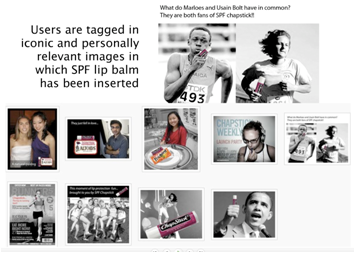
During my Healthcare Unbound Panel on “New Models in Social Media”, Kendra Markle from the Stanford Persuasive Technology Lab shared interesting examples of students designing their own social media interventions.
While co-creating with a consumer segment, you can design applications they value which leverage their relationships with their own social network and influence both personal and group behaviors.
Our Interview:
Sherri (Stepping Stone Partners): Tell me about how students define their own interventions. For example with SPF Stalker, what is the goal and how did students participate in this innovation process?
Kendra (Standford Persuasive Technology Lab):This project was created by some ingenious students as part of a class on habit formation taught by BJ Fogg, Director of the Stanford Persuasive Technology Lab. The project goal was to use technology to motivate people to wear sunscreen every day.
Students came up with this great idea to photoshop pictures of SFP chapstick into photos of famous people and photos they took of each other as a humorous way to remind each other about wearing SPF chapstick. By tagging their friends in the photos posted to Facebook, each friend gets an irresistible email from Facebook saying "you've been tagged! Click this link to see the photo". The response rates for click throughs on Facebook tagging emails is unbelievably high.
Sherri: What are the comments that students have shared about SPF Stalker? Why do they want to use it with their friends?
Kendra: This intervention was designed to be funny, which made the photos memorable enough to share with friends, thereby recruiting even more people into the intervention without them realizing it. We call this a stealth tactic - when people start engaging in healthier behavior without being explicitly told they're participating in a "health" app.
Sherri: What is the goal for the Healthy Check-ins project that you presented?
Kendra: The healthy check- ins project is also a stealth project, that's just our internal name for it. Our goal for the healthy check ins project is to combine the element of checking in with target health behaviors such as taking the stairs instead of the elevator, eating less meat or biking to work instead of driving. By checking in, many people feel some validation of their behavior, or feel they get credit for doing it by reporting it. We combined this urge with the fun of unrealistically awesome achievements from the game world to produce an experience that rewards you with virtual goods and powers that help you in the game world for indulging in the urge to check in your real behaviors. The motivation you feel to level up in the game layer can be translated into motivation to complete healthy behaviors just so that you can check them in.
Sherri: How do students feel the Healthy Check-ins will help them and their friends become more healthy (e.g. what is the value that students see?)
Kendra: So far, the students are excited about this project because it's something that they think they would use and could picture themselves getting a little addicted to. Since college aged kids want to do everything with their friends, we're working on making this intervention a social experience, one that requires use of both reciprocity and vengeance to advance. These are two behaviors that are believed to have evolved to encourage us to cooperate with each other. Cooperation is a very strong intrinsic motivator, as is competition, especially when both are used together.
Sherri: Since “location based services” (Foursquare like) are so popular, how have the students envisioned the connection between this capability and healthy locations for check-ins?
Kendra: We've expanded beyond location check ins to behavior check ins. Why is everyone feeling limited to location check ins? GPS technology provide convenient proof of presence at a location that can translate into monetary value but there are many other things that can be easily proved when using a mobile phone. It just takes some creativity. Students have come up with a whole bunch of target behaviors and creative ways to prove they're engaging in them, all while in stealth mode so the user never feels like they're supposed to be "getting healthy" while using the app.